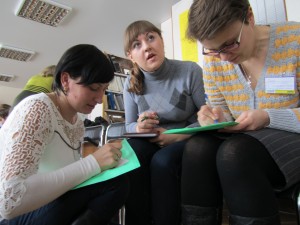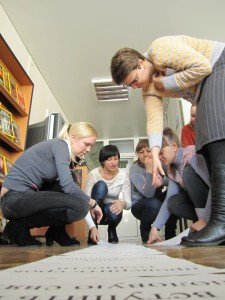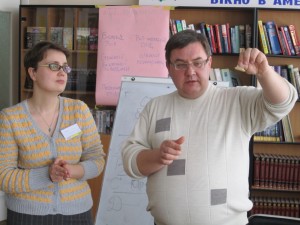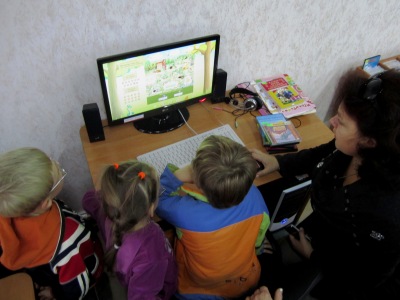HIV/AIDS Training in the WoA Center
More than 40 community leaders from Kirovograd received HIV/AIDS training at the WoA center yesterday and today, March 5 and 6.
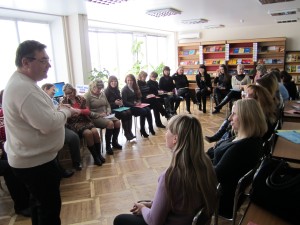 The program, which was a joint effort between the library and Peace Corps, was presented by a professional trainer from Kiev. Participants learned about the biology of HIV, how the virus is transmitted, methods for presenting information, and more in a format that consisted of a combination of presentation, discussion, and activities.
The program, which was a joint effort between the library and Peace Corps, was presented by a professional trainer from Kiev. Participants learned about the biology of HIV, how the virus is transmitted, methods for presenting information, and more in a format that consisted of a combination of presentation, discussion, and activities.
All of the participants said they were glad they came, and that they had received new information in an unusual and interesting manner. One participant said “I came here with a closed mind. I did not think I had anything new to learn, but I have not only learned new things but enjoyed how the material was presented.”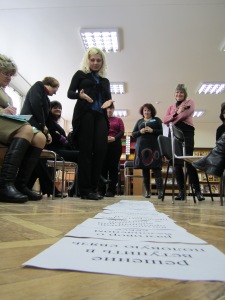
Peace Corps Volunteer Karin Jones said she thought it was important to conduct trainings like this for all ages and levels of knowledge because HIV is a growing problem in Ukraine, and it is very important that people be able to discuss it in an open manner.
Ukraine has one of the most severe HIV epidemics in Europe, with an infection rate of 1.6% of adults. The first case of HIV in Ukraine was detected in 1987. According to the 2007 Ukraine Demographic Health Survey, less than 50 percent of men and women have a comprehensive understanding of how to decrease the risk of HIV infection.
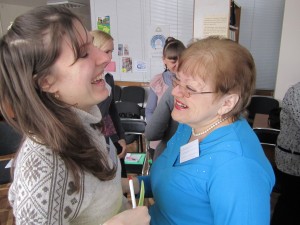 Through the U.S. Agency for International Development (USAID), Ukraine received $7.3 million in 2009 for essential HIV/AIDS programs and services. USAID’s HIV/AIDS programs in Ukraine are implemented as part of the U.S. President’s Emergency Plan for AIDS Relief (PEPFAR). Launched in 2003, PEPFAR is the U.S. government’s initiative to support partner nations around the world in responding to HIV/AIDS.
Through the U.S. Agency for International Development (USAID), Ukraine received $7.3 million in 2009 for essential HIV/AIDS programs and services. USAID’s HIV/AIDS programs in Ukraine are implemented as part of the U.S. President’s Emergency Plan for AIDS Relief (PEPFAR). Launched in 2003, PEPFAR is the U.S. government’s initiative to support partner nations around the world in responding to HIV/AIDS.
Be My Valentine
Valentine’s Day is one of the days of the year in the United States when people celebrate romance. But most people do not know the history of this day they associate with heart-shaped boxes of chocolate, flowers, and engagements.
Valentine’s Day, like Halloween, started off as a pagan holiday. At ancient Roman festivals,men stripped naked, grabbed goat- or dog-skin whips, and spanked young maidens in hopes of increasing their fertility. The annual celebration, called Lupercalia, was held every year on February 15 and remained wildly popular well into the fifth century C.E. —at least 150 years after Constantine made Christianity the official religion of the Roman Empire.
It is only later that the holiday became associated with a Catholic priest named Valentinus. In the third century A.D. Roman Emperor Claudius II, seeking to bolster his army, forbade young men to marry. Valentine, it is said, flouted the ban, performing marriages in secret. For his defiance, Valentinus was executed in C.E. 270—on February 14.
Another legend has it that Valentinus, imprisoned by Claudius, fell in love with the daughter of his jailer. Before he was executed, he allegedly sent her a letter signed “from your Valentine.”
When did Valentine’s Day become associated with romantic love?
It was not until the 14th century that this Christian feast day became definitively associated with love. According to UCLA medieval scholar Henry Ansgar Kelly, author of Chaucer and the Cult of Saint Valentine, it was Chaucer who first linked St. Valentine’s Day with romance.
In 1381, Chaucer composed a poem in honor of the engagement between England’s Richard II and Anne of Bohemia. As was the poetic tradition, Chaucer associated the occasion with a feast day. In “The Parliament of Fowls,” the royal engagement, the mating season of birds, and St. Valentine’s Day are linked:
For this was on St. Valentine’s Day,
When every fowl cometh there to choose his mate.
Valentine’s Day is said to have been brought to North America in the 19th century by British settlers.
In the United States, Valentine’s Day has become such a popular holiday that people spend more than $14 Billion in retail sales on it. The average person spends more than $100 on the holiday – on gifts, meals, and entertainment. Greeting cards are the most common Valentine’s Day gifts – about 190 million Valentine’s Day cards are sent each year. That figure does not include the hundreds of millions of cards schoolchildren exchange.
How did greeting cards become so popular?
The first Valentine’s Day card was sent in 1415 from France’s Duke of Orléans to his wife when he was a prisoner in the Tower of London following the Battle of Agincourt.
Valentine’s Day cards—mostly handwritten notes—gained popularity in the U.S. during the Revolutionary War. Mass production started in the early 1900s. In 1913, a company called Hallmark started putting out Valentine’s Day cards, and since that time, the company has developed cards for everyone from parents to children, siblings, and friends.
In addition, more than a billion dollars is spent each year on Valentine’s Day candy. About 75 percent of that billion is from sales of chocolate, which has been associated with romance at least since Mexico’s 15th- and 16th-century Aztec Empire. But just as popular are the small, heart-shaped candies known as sweetheart conversation hearts, with messages such as “BE MINE”, “KISS ME”, “SWEET TALK”, “I HOPE” and others.
Some people in the United States think that Valentine’s Day has become too commercial. Others embrace it and do everything from wear red to have parties to send greetings to everyone they know. It is also a popular day for men to propose to women, and for people to get married.
Although popular as a holiday, Valentine’s Day is not a public holiday, so all government buildings are open on that day.
World Volunteer Day!
Today is World Volunteer Day!
The International Volunteer Day for Economic and Social Development (IVD) was adopted by the United Nations General Assembly on 17 December 1985. Since then, governments, the UN system and civil society organizations have successfully joined volunteers around the world to celebrate the Day on 5 December.
IVD offers an opportunity for volunteer organizations and individual volunteers to make visible their contributions – at local, national and international levels.
However, volunteers continue to work on a daily basis to make our lives better. While newspapers may turn their attention elsewhere and sound bites may fade away, the work of volunteers goes on with or without publicity and well-deserved recognition.
Today, take a few minutes to tell a volunteer “Thank You for making a difference”. It means a lot to a person to know she is appreciated for the work she does – especially when the work is unpaid!
In addition, encouraging more people to volunteer is a 365-days-a-year task. Volunteering is an important way to develop societies and improve our lives. To learn more about IVD, click on World Volunteer Web.
World AIDS Day
Today is World AIDS Day.
World AIDS Day is held on 1 December each year and is an opportunity for people worldwide to unite in the fight against HIV, show their support for people living with HIV and to commemorate people who have died. World AIDS Day was the first ever global health day and the first one was held in 1988.
With an infection rate of around 1.6 to 1.8 percent, Ukraine has the highest rate of HIV/AIDS infection in Europe, and contributed nearly 21 percent of the newly reported HIV diagnoses in 2006 in the Europe and Eurasia region. Ukraine’s first case of HIV/AIDS was detected in 1987.
Annual HIV diagnoses in Ukraine have more than doubled since 2000. The spread of HIV has also increased in central, northern, and western regions, particularly in urban settings, where 78 percent of new cases registered in 2007 were among urban residents.
Low rates of HIV testing are a major challenge in combating the epidemic. In Ukraine, few people are tested for the disease, largely because of lack of access to testing centers, concerns for lack of privacy, and the stigma attached to testing and infection.
Contrary to popular opinion, HIV and AIDS in Ukraine are not limited to intravenous drug users (IDUs) and prostitutes, although those are the groups who are most at risk (as are the sexual partners of drug users). People in the most at-risk populations are particularly at risk due to their behaviors and the widespread stigma and discrimination against them and HIV-positive individuals.
Other factors contributing to the epidemic include high levels of migration and commercial sex, growing rates of sexually transmitted infections, increases in substance abuse, stigmatization and lack of effective treatment, and inadequate health care and social services.
While awareness of some preventive behaviors is high in Ukraine, less than 50 percent of men and women in Ukraine have a comprehensive understanding of how to decrease the risk of HIV infection, according to the 2007 Ukraine Demographic Health Survey.
How are Americans and Peace Corps Volunteers helping Ukraine with this problem? Through the U.S. Agency for International Development (USAID), Ukraine received $7.3 million in 2009 for essential HIV/AIDS programs and services. USAID’s HIV/AIDS programs in Ukraine are implemented as part of the U.S. President’s Emergency Plan for AIDS Relief (PEPFAR). Launched in 2003, PEPFAR is the U.S. Government’s initiative to support partner nations around the world in responding to HIV/AIDS. Through PEPFAR, the U.S. Government has committed approximately $32 billion to HIV/AIDS programs and the Global Fund.
Since 2002, USAID/Ukraine has worked with the government of Ukraine, other donors, multilateral and international agencies, NGOs and the private sector to prevent transmission of HIV and contain the spread of HIV. Current programs support efforts to strengthen the HIV/AIDS policy and legislative environment; provide prevention and care information and services for the most at-risk populations; reduce the stigma and discrimination associated with HIV/AIDS; and build governmental and nongovernmental capacity to plan, implement, manage, and monitor Ukraine’s National AIDS Program.
In addition, most Peace Corps Volunteers in Ukraine (there are currently 450 of us) conduct some sort of HIV/AIDS awareness and education program, trying to reach the next generation and teach them about how to avoid getting the disease. They also try to help reduce the stigma against people who have HIV/AIDS through their educational efforts.
Why is all of this important? Globally, an estimated 33.3 million people have HIV. More than 25 million people died from AIDS-related illnesses between 1981 and 2007, making AIDS one of the most destructive pandemics in history.
Today, many scientific advances have been made in HIV treatment, there are laws to protect people living with HIV and we understand so much more about the condition. But despite this, people do not know the facts about how to protect themselves and others from HIV, and stigma and discrimination remain a reality for many people living with HIV. World AIDS Day is important as it reminds the public and Government that HIV has not gone away – there is still a vital need to raise money, increase awareness, fight prejudice and improve education.
If you would like to learn more about HIV and AIDS, click on this link. Take action to educate yourself and others about HIV and AIDS, and learn how to treat people with HIV or AIDS with respect and understanding.
Happy Thanksgiving!
Today is Thanksgiving Day in the United States.
Thanksgiving is a very important holiday because not only was the first holiday the Pilgrims and Native Americans celebrated, in 1621, and there is evidence that it has earlier origins than that date. For example, there is evidence for an earlier celebration on the continent by Spanish explorers in Texas at San Elizaro in 1598, as well as thanksgiving feasts in the Virginia Colony. And well before that, both Native Americans and Europeans had been celebrating the end of the harvest by holding festivals and feasts.
For many years, Thanksgiving celebrations were held on different dates. This all changed when, in 1863, in an effort to foster a sense of unity between the Northern and Southern states, President Abraham Lincoln declared Thanksgiving a national holiday, and set the date at the final Thursday in November. This was changed to the fourth Thursday in November in 1941 by President Franklin Roosevelt.
How does a “typical” American family celebrate Thanksgiving? That depends on the family! Most families gather together and eat a meal that includes turkey, mashed potatoes, stuffing, cranberries, vegetables, yams, and pie – pecan, pumpkin, or apple. However, in the United States there are also vegetarian families who change the menu to suit their diet, regional differences, differences based on cultural backgrounds, or different traditions just because there are so many different families. In a country with 308 million people, it is hard to say that everyone does the same thing!
One thing all Americans have in common though – all know that the purpose of the holiday is to give thanks, and give thanks they do. Some people volunteer on Thanksgiving, others volunteer all year round. Some people donate money, others spend it on people they love. People express their gratitude in different ways.
We at the Kirovograd Window on America Center would like to wish our American friends – in Kirovograd, in Ukraine, and in America – a very Happy and Healthy Thanksgiving!
World Mental Health Day
Today is World Mental Health Day. World Mental Health Day raises public awareness about mental health issues. The day promotes open discussion of mental disorders and investments in prevention, promotion and treatment services.
Mental health is an integral and essential component of health. According to the World Health Organization (WHO), “Mental health is not just the absence of mental disorder. It is defined as a state of well-being in which every individual realizes his or her own potential, can cope with the normal stresses of life, can work productively and fruitfully, and is able to make a contribution to her or his community.” The WHO estimates that 450 million people worldwide suffer from mental or behavioral disorders or psychosocial problems, and that one person in four will be affected by a mental disorder at some stage of life.
It is important to note that a condition or disease that affects a person’s mental health is just as damaging as one that affects a person’s physical health. Unfortunately, though, in developing countries there is little recognition of the validity of such illnesses, and a great deal of stigma attached to them.
Stigma is a mark or label that leads to discrimination and remains one of the greatest barriers to people seeking treatment for mental health issues on a worldwide basis. Stigma affects peoples’ self-esteem, disrupts their family relationships, and limits their ability to socialize and to get housing and jobs. Stigma against mental illnesses is linked with discrimination and human rights abuses, with some of the most disturbing violations taking place in psychiatric hospitals. In both developing and wealthy nations, mental health services and institutions are underfunded and understaffed, functioning largely as warehouses for those who suffer.
Why does this stigma exist?
Unfortunately, stigma exists because of cultural beliefs about mental illness. Images and derogatory language in the media maintain beliefs about mental illness being incurable madness. Tabloids regularly use words such as ‘psycho’ and ‘bonkers’, which indicate a lack of sensitivity to people with mental illness. This encourages the public to believe that it is acceptable to fear and ridicule mental illness.Due to this lack of knowledge and the influence of stereotypes in media, the general public tend to view the mentally ill as unpredictable, responsible for their bizarre beliefs and behaviour, incapable of rational thought, and probably dangerous. When these beliefs filter through society at many levels it is no surprise that the mentally ill often find themselves socially excluded and isolated.
Mental illness is one of the invisible burdens on developing societies, accounting for four of the 10 leading causes of disability worldwide. The disease burden is greater than that of all cancers combined. Stigma and discrimination often define the barriers that prevent so many from accessing less costly and effective early interventions critical to maintaining a productive and meaningful life. If millions of people in both developed and developing countries could access appropriate mental health treatment without fear of labeling or discrimination, and could remain as productive and contributing members of the community, the economic benefits to communities would be countless.
Great strides have been made in the field of mental illness stigma research over the past decade through the efforts of many people that have devoted their careers to this issue. But much more needs to be done. We are learning a great deal about how to increase knowledge and understanding of mental illnesses – more people now believe in the effectiveness of treatments. Progress, however, in the area of changing attitudes and behaviors has been challenging.
What is important to foster good mental health? A climate that respects and protects basic civil, political, socio-economic and cultural rights is fundamental to mental health promotion. Without the security and freedom provided by these rights, it is very difficult to maintain a high level of mental health. According to the WHO, “National mental health policies should not be solely concerned with mental disorders, but should also recognize and address the broader issues which promote mental health. This includes mainstreaming mental health promotion into policies and programmes in government and business sectors including education, labour, justice, transport, environment, housing, and welfare, as well as the health sector.”
New Country Study Available!
One of the essential elements in a democratic society is the concept of Civic Responsibility – the fact that, as citizens of a democratic society, people not only have rights, but also responsibilities. The theory of “Active citizenship” says that citizens should work towards the betterment of their community through economic participation, public, volunteer work, and other such efforts to improve life for all citizens.
Civic responsibility can include participation in government, church, volunteers and memberships of voluntary associations. Actions of civic responsibility can be displayed in advocacy for various causes, such as political, economic, civil, environmental or quality of life issues. Although Civic Responsibility has existed for centuries in society, it was officially sanctioned as a blueprint for democracy in 1787 by the ratification of the United States Constitution.
By engaging in civic responsibility, citizens ensure and uphold certain democratic values, including justice, freedom, equality, diversity, authority, privacy, due process, property, participation, truth, patriotism, human rights, rule of law, tolerance, mutual assistance, self restraint and self respect.
The Kirovograd Oblast Library Named After Chizhevsky is pleased to offer our newest country study, called “Elements of Democracy – Civic Responsibility“. It is the third in our Democracy series – the first being What is Democracy and the second Elements of Democracy – Rule of Law.
Access Center a hit!
Since the opening of the new Access Center (for people with visual disabilities) at the library, the library has experienced a great deal of positive feedback, as well as many inquiries from people who would like to build the same kind of center at their libraries!
According to Peace Corps Volunteer Karin Jones, a number of other Volunteers have approached her to ask her about which program the Center uses, as their organizations have indicated they would like to use our center as a model. In addition, patrons from libraries in
other oblasts have found information about our center and called the library to gather more information about it.
Best of all, we have already had our youngest users come to visit the center. This morning, a group of children from a local school visited the center and were able to use the computers, as well as the developmental games the center offers.
Jones said that she had tears in her eyes while she was watching the children use the computers. “It is so rewarding to see the fruits of our teamwork in this way,” she said, “and I am so glad that these children, as well as many others, have this resource.”
Day of Democracy
Yesterday, September 15, was the International Day of Democracy. Today’s post is taken from Peace Corps Volunteer Karin Jones’ blog on what democracy means to her:
What Democracy Means to Me
Today is the International Day of Democracy. We hear this term used a great deal, especially when foreign countries go through an upheaval in their leadership. We banter it about in the United States, oftentimes without really knowing what we are talking about.
Democracy is, of course, in many ways an individual concept. So…what does democracy mean to me? It means:
- Power and civic responsibility are exercised by all citizens. How? Through citizen participation, including taking part in elections, running for office, organizing, demonstrating, etc.
- Majority rule and minority rights. Government is not centralized, and the majority respects the rights of the minority, even if they do not agree politically. The majority does not go out of its way to bully the minority party. Minorities are able to trust that their rights will be protected.
- Government is accessible and responsible to citizens, and operates in a transparent manner.
- The government protects the basic human rights of ALL citizens (equal protection of speech, freedom of religion, the right to equal protection under the law, and the opportunity to organize and participate fully in society).
- Citizens are able to exercise their voice, and their vote, in regular, free, and fair elections.
- Society is committed to the ideals of tolerance, cooperation, and compromise. People are free to follow their consciences in matters of religious faith. Individual religious beliefs are respected and the right to them is protected.
- Citizens follow the rule of law – no individual, whether President or private citizen, is above the law.
- Due process is followed by those who administer the criminal justice system. In other words, people are not imprisoned, tortured, lost their property, or killed without justification or formal charges being brought. The rules and procedures by which states enforce laws are not secret, but are public and explicit, and they are the same for everyone.
- The country has a constitution, which states government’s fundamental obligations and the limits on state power.
- The legislative, executive, and judicial powers of the government are separated, with checks and balances to ensure that none of them abuse their power.
- The judiciary is independent and impartial.
- A free and independent media.
- Political parties, NGOs, and interest groups. As annoying as people may find those that do not share their beliefs, such organizations cannot exist in a society that is non-democratic.
Remembering September 11, 2011
Today marks the tenth anniversary of the events that changed America, and the lives of all Americans, forever. On this day, there is much to ponder regarding the the meaning of love, hate, terrorism, peace, and how these impact us on a daily basis.
The Dalai Lama, always eloquent in his speech, had this to say today:
Today, as we mark the tenth anniversary of the September 11th 2001 attacks on New York and Washington DC, let us remember all the innocent lives lost and ponder the continuing impact of that tragic day. September 11th reminds us of the horror we human beings can unleash on ourselves when we allow our human intelligence and powerful technology to be overtaken by hatred.
We need to learn from our painful memories of September 11th and become more aware of the destructive consequences that arise when we give in to feelings of hatred. This tragedy in particular has reinforced my belief that fostering a spirit of peaceful co-existence and mutual understanding among the world’s peoples and faith traditions is an urgent matter of importance to us all. We must therefore make every effort to ensure that our various faith traditions contribute to build a more caring, peaceful world.
Would that we all were able to follow the example of this man, who reaches out in love not only to those who follow him and his teachings, but to everyone.
